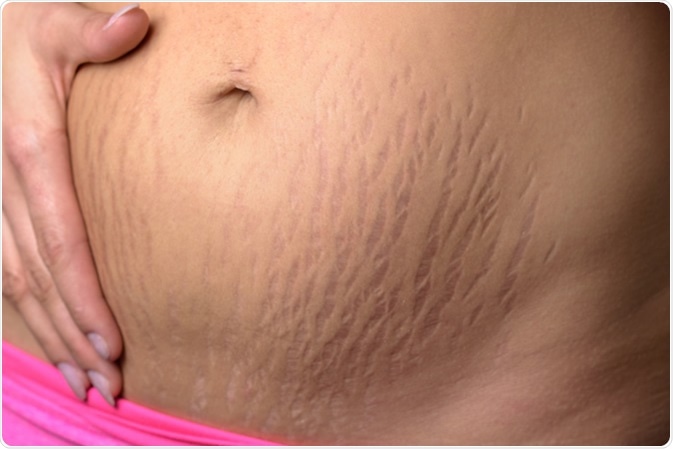Stretch marks, also known among medical professionals as Stritae distensae, are characteristic of a condition that involves inflammatory lesions on the skin.
While not life threatening, they may affect the quality of life and self-esteem of those affected, as they are not considered aesthetically appealing.
Stretch marks are more common in females, affecting 70% of adolescent females during puberty and up to 90% of pregnant women.
Stritae develop in two stages: red and inflamed in appearance in the beginning and then progressing into the second chronic stage, which appears whitish colored similar to scars.

Closeup of a pregnant belly with stretch marks. Image Credit: baipooh / Shutterstock
Symptoms
Symptoms usually present as the characteristic reddish, purple lines on the skin of affected areas, which do not usually cause pain. They are most commonly found where large amounts of fat are stored such as around the breast, buttocks, thighs and abdomen. Given time, they fade to a lighter translucent white lesion, which possess similarity in appearance and pathology to scarring of the skin.
Other symptoms are not usually evident, although many people feel self-conscious about the appearance of their skin and this can affect the way they interact with other people.

Woman displaying stretch marks on her abdomen after pregnancy caused by tearing of the dermis layer of the skin and showing as red discolorations, close up of her belly - Image Credit: Michaelheim / Shutterstock
Causes
While the exact pathogenesis of stretch marks remains unclear, there is a correlation observed in circumstances where the skin is stretched. Common examples of this are in pregnancy, rapid growth during puberty and significant weight change. They also tend to present perpendicular to where skin tension has occurred.
Some medications, such as corticosteroids, can also lead to stretch marks, as higher concentrations of glucocorticoids inhibit fibroblast activity and elasticity of the skin, imperative for keeping the skin taut and preventing tearing. This is also likely linked to stretch marks in pregnancy, as there is a higher cortisol concentration during pregnancy.
Prevention and Management
Hydrating body creams and oils applied during pregnancy have been shown to prevent or reduce the final severity of stretch marks in one literature review, although further evidence is lacking. If drastic a change in body size is expected, it would be good practice to use a body cream or oil as a preventative method.
Treatments available for stretch marks include topical treatments and laser therapies. These methods may improve the appearance of the marks in some patients, however there is rarely a full recovery in skin appearance, which can be frustrating for both patients and physicians. For best results, it is recommended to commence treatment early, before they reach the chronic stage and whitish color.
Topical retinoid creams, such as tretinoin, is thought to induce cell death and promote new skin growth in the area. This can often produce positive results, although the exact mechanism of the effect is not known. Silicone gels may also be effective in reducing the visibility of stretch marks, which are believed to hydrate the skin and realign skin fibers.
Fractional laser resurfacing has been shown to improve the appearance of stretch marks by creating controlled wounds and promoting growth and repair. It has been shown to be more effective than topical treatment, but needs to be performed by a dermatologist.
References
Further Reading